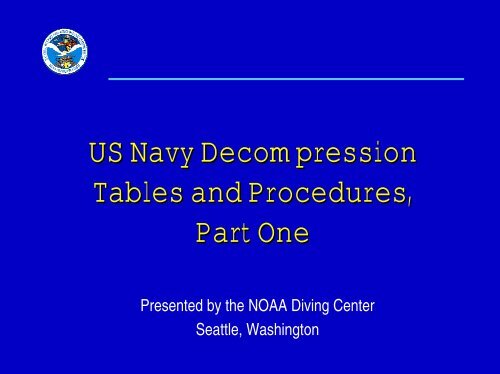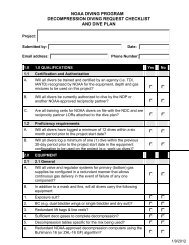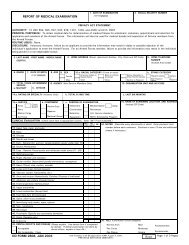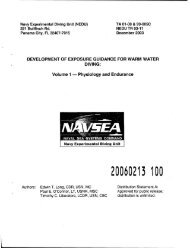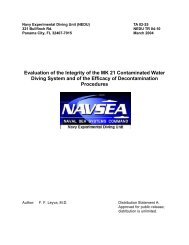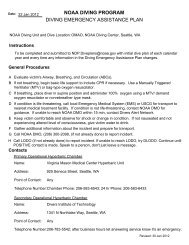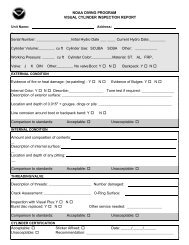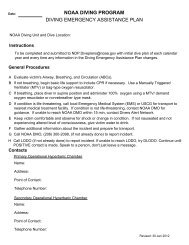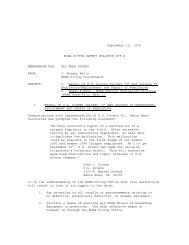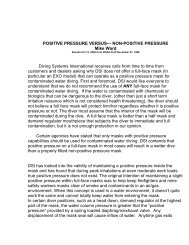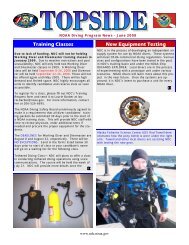US Navy Decompression Tables and Procedures, Part One
US Navy Decompression Tables and Procedures, Part One
US Navy Decompression Tables and Procedures, Part One
- No tags were found...
You also want an ePaper? Increase the reach of your titles
YUMPU automatically turns print PDFs into web optimized ePapers that Google loves.
<strong>US</strong> <strong>Navy</strong> <strong>Decompression</strong><strong>Tables</strong> <strong>and</strong> <strong>Procedures</strong>,<strong>Part</strong> <strong>One</strong>Presented by the NOAA Diving CenterSeattle, Washington
Global View• Table development• Definitions• Rules• No-decompression limits<strong>and</strong> Repetitive GroupDesignation table• Residual nitrogentimetables• Diagramming dives
• What are decompression tables?Introduction-1– Depth <strong>and</strong> time limits used to plan <strong>and</strong> conduct dives insuch a manner as to reduce the probability ofdecompression sickness.– <strong>Decompression</strong> tables take into consideration the amountof nitrogen absorbed by the body at various depths <strong>and</strong>times.– Other considerations are the allowable pressure gradientswhich can exist without excessive bubble formation <strong>and</strong>different gas elimination rates associated with variousbody tissues.
Introduction-2• Development of the <strong>US</strong>N <strong>Decompression</strong> tables– 1915: First set of decompression tables developed by French<strong>and</strong> Stillson for the <strong>US</strong>N Bureau of Construction <strong>and</strong>Repair– 1935: Second generation tables developed by Hawkins,Shillings, <strong>and</strong> Hanson– 1937: Third generation tables developed by Yarborough– 1951: Fourth generation developed by Van Der Aue– 1956: Fifth generation tables developed by Des Granger,Dwyer, <strong>and</strong> Workman developed with a UNIVACcomputer <strong>and</strong> tested with approximately 600 man-divesat the <strong>US</strong>N EDU
Table Definitions-1• Depth: Maximum depth attained during a dive• Actual Bottom Time (ABT): Time from leaving surface untilbeginning a direct ascent to the surface• <strong>Decompression</strong>: Process of eliminating nitrogen from the bodyduring ascent– Linear: <strong>One</strong> continuous ascent without stopping– Staged: Stops for specific times at specific depths duringascent• No-<strong>Decompression</strong> limits: Maximum time that can be spent at agiven depth without requiring staged decompression
Table Definitions-3• Repetitive Group Designation (RGD): A letter that designatesthe amount of nitrogen remaining in a diver’s body during a12-hour period following a dive• Residual Nitrogen Time (RNT): Time (minutes) that must beconsidered when calculating the bottom time of a repetitivedive to compensate for nitrogen remaining in a diver’s tissuesfrom a previous dive.• Equivalent Single Dive Time (ESDT): Time (minutes) used toselect a schedule for a single repetitive dive. Equal to thebottom time of the planned repetitive dive plus the diver’sresidual nitrogen time (ABT + RNT)
<strong>US</strong>N No-Deco <strong>Tables</strong>-2No-<strong>Decompression</strong> Limits <strong>and</strong> Repetitive Group Designation Table For No-<strong>Decompression</strong> Air Dives - 1999Depth Max A B C D E F G H I J K L M N O10 60 120 210 300 797 *15 35 70 110 160 225 350 452 *20 25 50 75 100 135 180 240 325 390 917 *25 595 20 35 55 75 100 125 160 195 245 315 361 540 59530 405 15 30 45 60 75 95 120 145 170 205 250 310 344 40535 310 5 15 25 40 50 60 80 100 120 140 160 190 220 270 31040 200 5 15 25 30 40 50 70 80 100 110 130 150 170 20050 100 10 15 25 30 40 50 60 70 80 90 10060 60 10 15 20 25 30 40 50 55 6070 50 5 10 15 20 30 35 40 45 5080 40 5 10 15 20 25 30 35 4090 30 5 10 12 15 20 25 30100 25 5 7 10 15 20 22 25110 20 5 10 13 15 20120 15 5 10 12 15130 10 5 8 10
• Description:<strong>US</strong>N No-Deco <strong>Tables</strong>-3– First vertical column on far left lists various depths from 10to 190 fsw– Second vertical column from the left lists depths from 3 to59.9 meters– Third vertical column from the left indicates the maximumNo-decompression Limits in minutes for each depth– Remaining vertical columns list specific bottom timesranging from 5 minutes To 917 minutes– Horizontal top row lists the repetitive group designation fromA to O
<strong>US</strong>N No-Deco <strong>Tables</strong>-5• Application:– Locate exact or next greaterdepth from vertical column onfar left– Move horizontally to locateexact or next greater bottomtime– Move vertically to the top ofthe page <strong>and</strong> read therepetitive group designation(RGD) letterFSW MAX A B C D E F10 60 120 210 300 797 *15 35 70 110 160 225 35020 25 50 75 100 135 18025 595 20 35 55 75 100 12530 405 15 30 45 60 75 9535 310 5 15 25 40 50 6040 200 5 15 25 30 40 5050 100 10 15 25 30 4060 60 10 15 20 25 30
• Question #4:<strong>US</strong>N No-Deco <strong>Tables</strong>-10– What would be the RGD for a dive to 115 fsw for 14 minutes?FSW MAX A B C D E F G H I J K L M N O100 25 5 7 10 15 20 22 25110 20 5 10 13 15 20120 15 5 10 12 15130 10 5 8 10
• Answer to question #4:<strong>US</strong>N No-Deco <strong>Tables</strong>-11FSW MAX A B C D E F G H I J K L M N O100 25 5 7 10 15 20 22 25110 20 5 10 13 15 20120 15 5 10 12 15130 10 5 8 10– The RGD for a dive to 115 fsw for 14 minutes is F
<strong>US</strong>N Repetitive Dive <strong>Tables</strong>-1• Residual nitrogen timetable for repetitive air dive– Surface Interval Table– Residual Nitrogen Table• Purpose: To provide a means to determine theamount of nitrogen remaining in a diver’s body whenplanning a repetitive dive
• Surface Interval Credit Table– Credits time that a diver at thesurface off-gasses nitrogen– Minimum SIT must be 10minutes– A dive started less than 10minutes after a previous dive isconsidered part of the samedive<strong>US</strong>N Repetitive Dive <strong>Tables</strong>-2– Dives 12 hours or more aftera previous dive are not repetitivedives <strong>and</strong> do not require RNTcalculationE 0:100:54D 0:101:09C 0:101:390:551:57B 0:103:201:102:381:583:24A 0:1012:001:404:492:395:483:256:343:2112:004:5012:005:4912:006:3512:00F 0:100:450:461:291:302:282:293:573:587:057:0612:00F E D C B A
<strong>US</strong>N Repetitive Dive <strong>Tables</strong>-3• Description--Surface Interval Credit Table:– Diagonal = Beginning RGD– 16 columns in hours : minutes– Bottom horizontal = Ending RGDZ0:100:22O 0:100:23H 0:100:36G 0:100:40F0:100:45E0:100:540:411:15Repetitive group at the beginning of the surface intervalN0:100:240:230:34M 0:100:250:240:360:350:48L0:100:260:250:390:370:510:491:02K 0:100:280:260:420:400:540:521:071:031:18J0:100:310:270:450:430:590:551:111:081:241:191:36I0:100:330:290:490:461:041:001:181:121:301:251:431:371.550:320:540:501:111:051:251:191:351:311:531:442:041:562:170:340:590:551:191:121:351:261:491:402:051:542:182:052:292:182:420:371:061:001:291:201:471:362:031:502:192:062:342:192:472:302:592:433:101:071:411:302:021:482:202:042:382:202:532:353:082:483:223:003:333:113:45D0:101:090:461:291:161:591:422:232:032:442:213:042:393:212:543:363:093:523:234:043:344:173:464:29C0:101:390:551:571:302:282:002:582:243:202:453:433:054:023:224:193:374:353:534:494:055:034:185:164:305:27B 0:103:201:102:381:583:242:293:572:594:253:214:493:445:124:035:404:205:484:366:024:506:185:046:325:176:445:286:56A 0:1012:001:404:492:395:483:256:343:587:054:267:354:507:595:138:215:418:505:498:586:039:126:199:286:339:436:459:546:5710:05Z O N M L K J I H G F E D C B A3:2112:004:5012:005:4912:006:3512:007:0612:007:3612.008:0012:008:2212:008:5112:008:5912:009:1312:009:2912:009:4412:009:5512:0010:0612:00
<strong>US</strong>N Repetitive Dive <strong>Tables</strong>-4• Application--SIT:– Enter the schedule on thediagonal slope using theRGD from the previous dive– Read horizontally until thesurface interval is equal to,or between, the timesshown in the schedule– Read the new RGD at thebottom of the columnINF0:100:45E0:100:54D0:101:090:461:29C0:101:390:551:571:302:28B0:103:201:102:381:583:242:293:57A0:1012:001:404:492:395:483:256:343:587:053:2112:004:5012:005:4912:006:3512:007:0612:00F E D C B AOUT
<strong>US</strong>N Repetitive Dive <strong>Tables</strong>-5• Residual Nitrogen Timetable– Used to determine the amount of nitrogen (RNT) that must beconsidered for repetitive dives– RNT is considered time that the diver has already spent atdepth for the planned repetitive dive– When the SIT is less than 10 minutes, the RNT for a repetitivedive is the same as the ABT from the previous diveZ O N M L K J I H G F E D C B A10 ** ** ** ** ** ** ** ** ** ** ** 797 279 159 88 3920 ** ** ** ** ** ** 917 399 279 208 159 120 88 62 39 1830 † † † 349 279 229 190 159 132 109 88 70 54 39 25 1240 257 241 213 187 161 138 116 101 87 73 61 49 37 25 17 750 169 160 142 124 111 99 87 76 66 56 47 38 29 21 13 6
<strong>US</strong>N Repetitive Dive <strong>Tables</strong>-6• Description--Residual Nitrogen Timetable:– Far left column lists depth of the repetitive dive from 10 to 190 fsw– 16 columns of residual nitrogen times for specific depthsZ O N M L K J I H G F E D C B A10 ** ** ** ** ** ** ** ** ** ** ** 797 279 159 88 3920 ** ** ** ** ** ** 917 399 279 208 159 120 88 62 39 1830† † † 349 279 229 190 159 132 109 88 70 54 39 25 1240 257 241 213 187 161 138 116 101 87 73 61 49 37 25 17 750 169 160 142 124 111 99 87 76 66 56 47 38 29 21 13 660 122 117 107 97 88 79 70 61 52 44 36 30 24 17 11 570 100 96 87 80 72 64 57 50 43 37 31 26 20 15 9 4
• Application--RNT:<strong>US</strong>N Repetitive Dive <strong>Tables</strong>-7– Enter the timetable vertically with the RGD from the SIT table– Read directly the bottom time to be added to the repetitivedive in the depth row for the diveZ O N M L K J I H G F E D C B A10 ** ** ** ** ** ** ** ** ** ** ** 797 279 159 88 3920 ** ** ** ** ** ** 917 399 279 208 159 120 88 62 39 1830 † † † 349 279 229 190 159 132 109 88 70 54 39 25 1240 257 241 213 187 161 138 116 101 87 73 61 49 37 25 17 750 169 160 142 124 111 99 87 76 66 56 47 38 29 21 13 660 122 117 107 97 88 79 70 61 52 44 36 30 24 17 11 570 100 96 87 80 72 64 57 50 43 37 31 26 20 15 9 480 84 80 73 68 61 54 48 43 38 32 28 23 18 13 8 4
<strong>US</strong>N Repetitive Dive <strong>Tables</strong>-8• Question #1:– What is the Residual Nitrogen Time (RNT) for a Group Gdiver planning a repetitive dive to 75 fsw after a SurfaceInterval (SIT) of 2½ hours?
<strong>US</strong>N Repetitive Dive <strong>Tables</strong>-9• Answer to question #1:E0:100:540:551:571:583:243:256:34– RNT = 18 mins.F0:100:450:461:291:302:282:293:573:587:05G 0:100:400:411:151:161:592:002:582:594:254:267:35H 0:100:360:371:061:071:411:422:232:243:203:214:494:507:59I0:100:330:340:591:001:291:302:022:032:442:453:433:445:125:138:21I H G F E D C B6070809061 52 44 36 30 24 17 1150 43 37 31 26 20 15 943 38 32 28 23 18 13 838 33 29 24 20 16 11 7
<strong>US</strong>N Repetitive Dive <strong>Tables</strong>-10• Question #2:– What is the RNT for a Group C diver planning arepetitive dive to 65 fsw after an SIT of 1 hour <strong>and</strong> :05minutes?
<strong>US</strong>N Repetitive Dive <strong>Tables</strong>-11• Answer to question #2:– RNT = 15 mins.C0:101:39B0:103:20A0:1012:001:404:493:2112:004:5012:00D 0:101:091:102:382:395:485:4912:00E0:100:540:551:571:583:243:256:346:3512:00E D C B A5060708038 29 21 13 630 24 17 11 526 20 15 9 423 18 13 8 4
<strong>US</strong>N Repetitive Dive <strong>Tables</strong>-12• Question #3:– A diver makes a dive to 95 fsw for 20 minutes. After asurface interval of 2½ hours, the diver wants to make asecond dive to 90 fsw. What’s the maximum nodecompressiontime allowed on the second dive?
Diagramming Dives• Depth = Vertical axis Time = Horizontal axisRGD SIT RGD RGD SIT RGDRGDDepthTime____ ABT____ RNT+____ ABT____ ESDT____ RNT+____ ABT____ ESDT
<strong>US</strong>N Repetitive Dive <strong>Tables</strong>-13• Answer to question #3: Maximum of 19 minutesF2:30CH95’ 100’/:20 90’ 90’/:3020 ABT11 RNT19 ABT30 ESDT
Key Points• Know the dive table terms <strong>and</strong> abbreviations• Always follow the dive table rules--DO NOTINTERPOLATE• Learn when to use which dive table• Always diagram dives• Ascend no faster than 30 fpm• Good table use requires frequent practice


